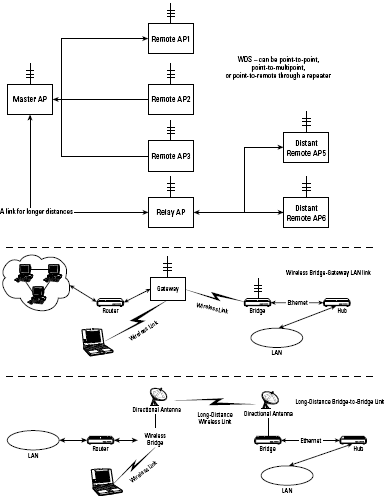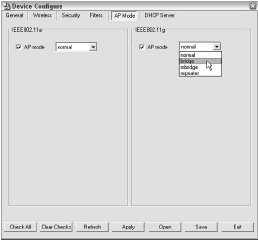Bridging is a connection you make between two LANs at the link layer, each node of which is identified by the device’s MAC address. Any node on an IP network has a MAC address, and this is the way access points and network cards recognize each other.
You’ll find that there are several different ways to create wireless links and bridges:
- Many wireless gateways come with the Wireless Distribution System (WDS) technology by which the gateway can serve the dual role of bridge and access point (provided that there is sufficient bandwidth available to do so). The simplest solutions are a wireless repeater and a wireless bridge with one access point on each side of a WDS connection.
- Two (or more) access points can create a connection that is a bridge-only mode for either point-to-point, point-to-multipoint, or redundant bridging. To do this, your access point or router must be capable of bridging mode.
- You can use an 802.11 to Ethernet bridge that can connect to a hub or switch on one side and act as an access point or bridge node on the other.
- You can create a dual homed system containing two wireless NIC cards and have one card connect to your network as a bridge and the other serve as an access point.
Doing so lets you create a system where each different NIC card can be on a different subnet, running different protocols, or isolated from one another in some other way. With protocol isolation you have essentially created a firewall situation that makes it much harder for a hacker to penetrate your network.
Figure 1 shows some examples of bridging topologies.
Bridging LAN Wirelessly
The simple act of adding more access points so that coverage overlaps was covered in later. The essential point to consider is that each access point on the same wireless network must have the same SSID value.
The SSID value is the network name by definition. When you are overlapping wireless access points, they must use different channels (either 1, 6, or 11). Once you start adding wireless bridges these facts still apply.
However, when you use repeaters in place of access points they use the same channels for transmission. If you have two separate networks in your home and office, each with its own separate address pools, and you wish to bridge them, you would normally connect two of the hubs or switches on each network with a wired connection.
If a direct Ethernet connection isn’t possible, you might try establishing a connection using the electrical wiring in your house or office. There are instances where even those kinds of connections aren’t possible or desirable and it makes sense to bridge two networks with wireless devices.
The essential connection sets up an access point on each LAN in a bridging mode and then connects the networks together. Figure 2 shows a D-Link access point being set for bridging mode.
Here are some scenarios in which a wireless bridging solution for two LANs makes sense:
- You need to find a way to inexpensively connect two separate LANs.
- You need the flexibility to connect to an inconvenient or a changing location.
- You want a secondary means of connecting two LANs for fault tolerance.
- You want to link a wireless LAN to a network with Internet access.
There are many more places where a wired connection makes sense even if it costs more. The arguments for a wired connection are faster throughput, better reliability, easier management, and better security.
So before you create this kind of connection, you need to ask yourself if it is really necessary or desirable. Adding an additional wireless network to a LAN that already has one isn’t much different than adding the first one.
You can add your wireless router or access point any place that you can connect to your network. With wireless technology that’s really the rub, because the places you want to put a wireless signal are the places where you can’t get your wires to go to.
So the choices you have are extending your wireless network so that coverage of two or more wireless networks can overlap, or finding another way to get your wired LAN to a point where it can support a wireless connection.

